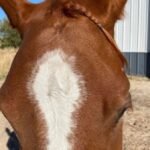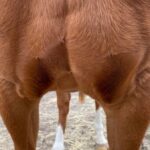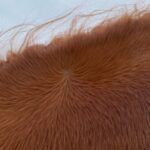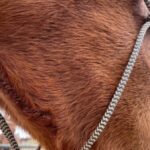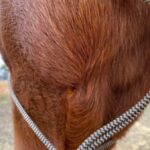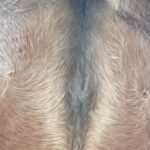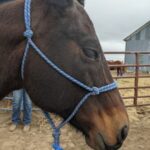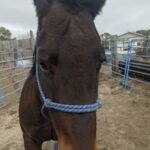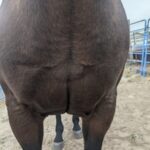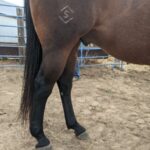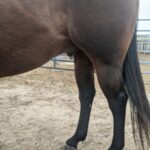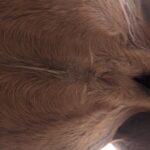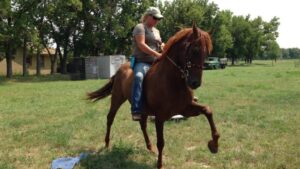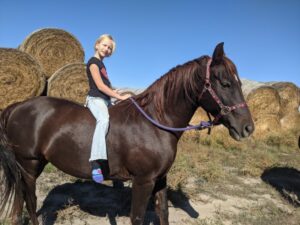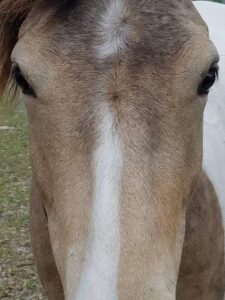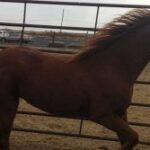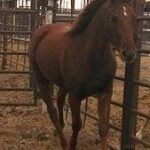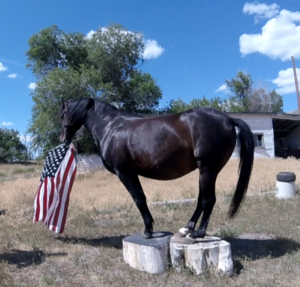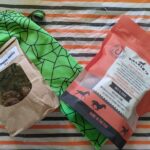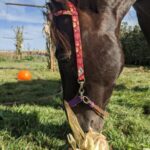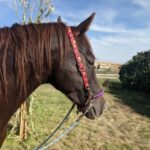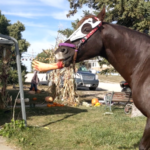High double side by side whorls show a horse who is sensitive, and an extremely quick learner. Bold, calm, curious, and confident, they can concentrate intently on a job but will get bored with repetition. You have to give them a reason to be interested, repetition bores them and they will start to look for other ways to entertain themselves. When that intelligence, sensitivity, and focus is properly contained they can be a super power. Without steady confident handling they can completely run over a person smashing through them literally as well as figuratively.
The whorls have feathering coming up from both of them. Feathering shows a brave and curious horse. They are thinkers who can think up all sorts of trouble with their very active minds. They are curious and clever, very friendly and add even more pushiness to an already assertive demanding horse.
A confident horse who has no hesitation about pushing through, or over people can cause trouble with the wrong people, ones who are easily intimidated. The traits themselves are in no way a bad thing. They can be an incredible thing. With the right training.
This mare was striking when unhappy and running people over when they tried to make her do things she didn’t want to do. She will not be forced into doing anything. In this case refusing dewormming or shots.
Luckily they sent her to the right place to find help. Positive reinforcement training works wonders with this type of horse. They can not be forced to do anything. If you can convince them that it will be a good thing and give them proper incentive, these horses will do anything for you. They will also stand at the gate and demand that you come work them with the same fervor that they refuse to do things that are forced on them. The determination and focus they are able to give needs to be directed in a healthy happy fashion. Once that is accomplished they make amazing horses, fearless, sensitive, devoted.
Looking at whorls on horses is not about labeling them, jumping to conclusions before allowing the horse to tell us who they are. It is about gaining every clue we can to what will best suit the horse. It is about finding the best matches between horse, human, and training style before huge commitments are made to everyone’s detriment.
Beyond the whorls on the head we can look at the rest of the body and see how the horse will move. Whorls are closely tied to conformation and muscle capability.
One her chest this mare has a small center whorl. That will bring her neck down to come lower out of the chest and put her a bit onto the forequarters. It is small so the effects it has shouldn’t be overly dramatic.The whorls on the crest of the neck show where she will bend through the neck when she tucks her nose. Whorls on the underside of the jaw are easily over looked but extremely important. When these aren’t evenly placed it will affect the entire body to the point that front hooves will grow unevenly. Even the whorls on the underside of the belly have information to give us. Where these are placed is where the hind legs will track. Hers appear to be mostly even, spaced moderately apart, and up a nice distance under the belly. Sometimes they will be in the center or placed with one far forward and one towards the back. In extreme cases one side wont have a whorl at all. Those horses have lots of trouble controlling hind legs and performing basic gaits.
This mare has all the makings of a very nice horse. No body issues and forehead whorls that can make a great horse. Hopefully when she goes home the training will be able to continue.
